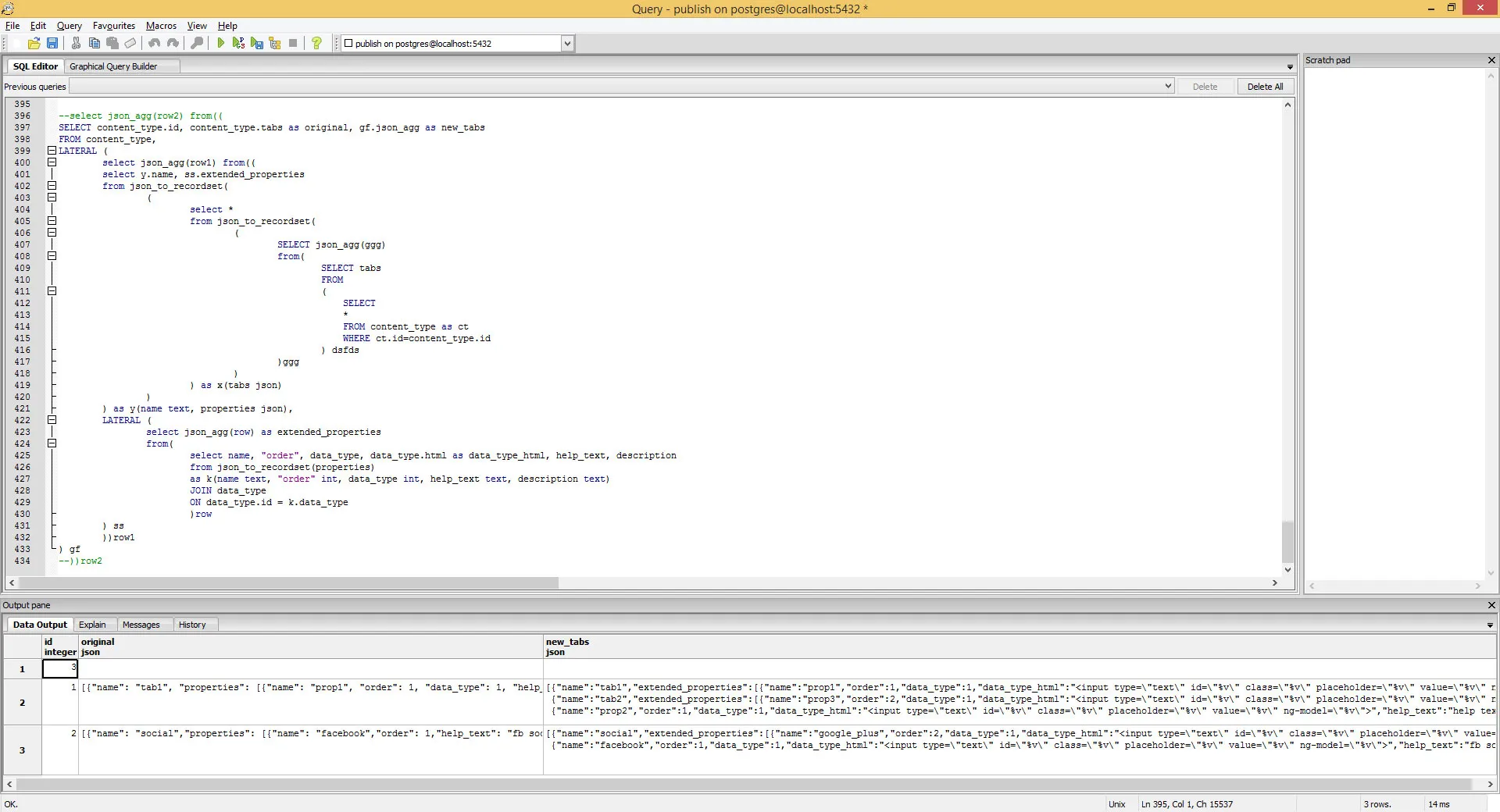假设您有以下表格,比如:
现在我想要实现的是像以下伪代码一样进行连接:
希望我说的有道理,你可以帮我解决问题吗?因为我好像有些卡住了。
顺便提一下,我在使用最新的9.4beta3。
我在这里找到了一个链接,让我对于PostgreSQL能够实现这个功能充满了希望:http://www.slideshare.net/EnterpriseDB/no-37327319(请看第17页)。
其他可能有用的链接:
- http://michael.otacoo.com/postgresql-2/manipulating-jsonb-data-with-key-unique/ - http://hashrocket.com/blog/posts/faster-json-generation-with-postgresql - PostgreSQL 9.2 row_to_json() with nested joins - http://info.enterprisedb.com/rs/enterprisedb/images/EDB_White_Paper_Using_the_NoSQL_Features_in_Postgres.pdf(第13页)
我试着做了一些实验,这是我目前的进展:
表格:content_type
- id serial 非空
- tabs json
表格:data_type
- id serial 非空
- html 文本
这只是一个小例子来说明。
存储在tabs中的json可能像这样:
[
{
"name": "tab1",
"properties":
[{
"name": "prop1",
"order": 1,
"help_text": "help text",
"description": "description",
"data_type": 1
}]
},
{
"name": "tab2",
"properties":[{
"name": "prop2",
"order": 1,
"help_text": "help text2",
"description": "description2",
"data_type": 1
},
{
"name": "prop3",
"order": 2,
"help_text": "help text3",
"description": "description3",
"data_type": 1
}]
}
]
现在我想要实现的是像以下伪代码一样进行连接:
SELECT content_type.id, content_type.tabs, data_type.id, data_type.html
FROM content_type
JOIN data_type
ON data_type.id = content_type.tabs::json->'data_type'::int
实际上,data_type.id和data_type.html是与选项卡属性的data_type连接在一起,而不像通常的联接查询中那样作为单独的列。
基本上,我要寻找的结果就好像是将2个或更多表通过id列连接起来一样,只是在这种情况下,“表”之一位于json对象的数组内。
是的,我知道上面的联接尝试非常偏离正题,因为我想要将附加属性“添加/追加”到修改过的选项卡json列的版本中,而不是作为额外的单独列。
在这种情况下,联接将在选择/联接查询中返回选项卡json数组中的id,并使用联接获取的附加属性进行扩展,因此它不仅仅是一个“data_type”:1,而是返回类似于以下内容:
"data_type": {
"id":1,
"html": "<input type='text' id='%v' class='%v' placeholder='%v' value='%v' ng-model='%v'>"
}
......当然还有其他的属性。这仅仅是一个简单的例子,用于说明问题。
[
{
"name": "tab1",
"properties":
[{
"name": "prop1",
"order": 1,
"help_text": "help text",
"description": "description",
"data_type": {
"id":1,
"html": "<input type='text' id='%v' class='%v' placeholder='%v' value='%v' ng-model='%v'>"
... and of course additional columns fetched from the data_type table, and added to the select return in our join, to manipulate the original json array of tabs->properties->data_type
}
}]
},
{
"name": "tab2",
"properties":[{
"name": "prop2",
"order": 1... etc
希望我说的有道理,你可以帮我解决问题吗?因为我好像有些卡住了。
顺便提一下,我在使用最新的9.4beta3。
我在这里找到了一个链接,让我对于PostgreSQL能够实现这个功能充满了希望:http://www.slideshare.net/EnterpriseDB/no-37327319(请看第17页)。
其他可能有用的链接:
- http://michael.otacoo.com/postgresql-2/manipulating-jsonb-data-with-key-unique/ - http://hashrocket.com/blog/posts/faster-json-generation-with-postgresql - PostgreSQL 9.2 row_to_json() with nested joins - http://info.enterprisedb.com/rs/enterprisedb/images/EDB_White_Paper_Using_the_NoSQL_Features_in_Postgres.pdf(第13页)
我试着做了一些实验,这是我目前的进展:
SELECT content_type.id, content_type.tabs as original, gf.json_agg as new_tabs
FROM content_type,
LATERAL (
select json_agg(row1) from((
select y.name, ss.extended_properties
from json_to_recordset(
(
select *
from json_to_recordset(
(
SELECT json_agg(ggg)
from(
SELECT tabs
FROM
(
SELECT
*
FROM content_type as ct
WHERE ct.id=content_type.id
) dsfds
)ggg
)
) as x(tabs json)
)
) as y(name text, properties json),
LATERAL (
select json_agg(row) as extended_properties
from(
select name, "order", data_type, data_type.html as data_type_html, help_text, description
from json_to_recordset(properties)
as k(name text, "order" int, data_type int, help_text text, description text)
JOIN data_type
ON data_type.id = k.data_type
)row
) ss
))row1
) gf
这导致以下结果(在浏览器中放大以查看图像中的文本-按住ctrl +滚轮向上或键盘上的加号):

至少现在我可以将data_type.html放入其中,尽管我更喜欢 "data_type": {"id": 1, "html": "[somehtmlhere]"}。
由于某种原因,它不允许我将json_agg包装起来,并将输出显示为1个组合的json文档。不理解为什么,但猜想它与LATERAL有关,可能是PostgreSQL 9.4 beta3中的一个错误。
我知道肯定有更好的方法和解决方案 - 我对pgSQL或pg一般并不是很有经验......但,希望能够学到。